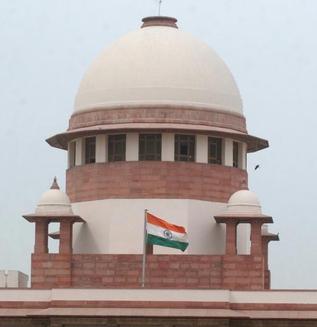The Supreme Court in D Veluswamy Vs D Patchaiammal has explained the definition of Live In Relationships with reference to Domestic Violence Act. The Court in its judgement in the mentioned ruled:

SUPREME COURT OF INDIA
16. However, the question has also be to be examined from the point of view of The Protection of Women from Domestic Violence Act, 2005.
Section 2(a) of the Act states :
“2(a) “aggrieved person” means any woman who is, or has been, in a domestic relationship with the respondent and who alleges to have been subjected to any act of domestic violence by the respondent”;
Section 2(f) states :
“2(f) “domestic relationship” means a relationship between two persons who live or have, at any point of time, lived together in a shared household, when they are related by consanguinity, marriage, or through a relationship in the nature of marriage, adoption or are family members living together as a joint family”;
Section 2(s) states :
“2(s) “shared household” means a household where the person aggrieved lives or at any stage has lived in a domestic relationship either singly or along with the respondent and includes such a household whether owned or tenanted either jointly by the aggrieved person and the respondent, or owned or tenanted by either of them in respect of which either the aggrieved person or the respondent or both jointly or singly have any right, title, interest or equity and includes such a household which may belong to the joint family of which the respondent is a member, irrespective of whether the respondent or the aggrieved person has any right, title or interest in the shared household.”
Section 3(a) states that an act will constitute domestic violence in case it-
“3(a) harms or injures or endangers the health, safety, life, limb or well-being, whether mental or physical, of the aggrieved person or tends to do so and includes causing physical abuse, sexual abuse, verbal and emotional abuse and economic abuse;” or (emphasis supplied)
17. The expression “economic abuse” has been defined to include :
“(a) deprivation of all or any economic or financial resources to which the aggrieved person is entitled under any law or custom whether payable under an order of a court or otherwise or which the aggrieved person requires out of necessity including, but not limited to, household necessities for the aggrieved person and her children, if any, stridhan, property, jointly or separately owned by the aggrieved person, payment of rental related to the shared household and maintenance”.
(emphasis supplied)
18. An aggrieved person under the Act can approach the Magistrate under Section 12 for the relief mentioned in Section 12(2). Under Section 20(1)(d) the Magistrate can grant maintenance while disposing of the application under Section 12(1).
19. Section 26(1) provides that the relief mentioned in Section 20 may also be sought in any legal proceeding, before a civil court, family court or a criminal court.
20. Having noted the relevant provisions in The Protection of Women from Domestic Violence Act, 2005, we may point out that the expression `domestic relationship’ includes not only the relationship of marriage but also a relationship `in the nature of marriage’. The question, therefore, arises as to what is the meaning of the expression `a relationship in the nature of marriage’. Unfortunately this expression has not been defined in the Act. Since there is no direct decision of this Court on the interpretation of this expression we think it necessary to interpret it because a large number of cases will be coming up before the Courts in our country on this point, and hence an authoritative decision is required.
21. In our opinion Parliament by the aforesaid Act has drawn a distinction between the relationship of marriage and a relationship in the nature of marriage, and has provided that in either case the person who enters into either relationship is entitled to the benefit of the Act.
22. It seems to us that in the aforesaid Act of 2005 Parliament has taken notice of a new social phenomenon which has emerged in our country known as live-in relationship. This new relationship is still rare in our country, and is sometimes found in big urban cities in India, but it is very common in North America and Europe. It has been commented upon by this Court in S. Khushboo vs. Kanniammal & Anr. (2010) 5 SCC 600 (vide
para 31).
23. When a wife is deserted, in most countries the law provides for maintenance to her by her husband, which is called alimony. However, earlier there was no law providing for maintenance to a woman who was having a live-in relationship with a man without being married to him and was then deserted by him.
24. In USA the expression `palimony‘ was coined which means grant of maintenance to a woman who has lived for a substantial period of time with a man without marrying him, and is then deserted by him (see `palimony’ on Google). The first decision on palimony was the well known decision of the California Superior Court in Marvin vs. Marvin (1976) 18 C3d660. This case related to the famous film actor Lee Marvin, with whom a lady Michelle lived for many years without marrying him, and was then deserted by him and she claimed palimony. Subsequently in many decisions of the Courts in USA, the concept of palimony has been considered and developed. The US Supreme Court has not given any decision on whether there is a legal right to palimony, but there are several decisions of the Courts in various States in USA. These Courts in USA have taken divergent views, some granting palimony, some denying it altogether, and some granting it on certain conditions. Hence in USA the law is still in a state of evolution on the right to palimony.
25. Although there is no statutory basis for grant of palimony in USA, the Courts there which have granted it have granted it on a contractual basis. Some Courts in USA have held that there must be a written or oral agreement between the man and woman that if they separate the man will give palimony to the woman, while other Courts have held that if a man and woman have lived together for a substantially long period without getting married there would be deemed to be an implied or constructive contract that palimony will be given on their separation.
26. In Taylor vs. Fields (1986) 224 Cal. Rpr. 186 the facts were that the plaintiff Taylor had a relationship with a married man Leo. After Leo died Taylor sued his widow alleging breach of an implied agreement to take care of Taylor financially and she claimed maintenance from the estate of Leo. The Court of Appeals in California held that the relationship alleged by Taylor was nothing more than that of a married man and his mistress. It was held that the alleged contract rested on meretricious consideration and hence was invalid and unenforceable. The Court of Appeals relied on the fact that Taylor did not live together with Leo but only occasionally spent weekends with him. There was no sign of a stable and significant cohabitation between the two.
27. However, the New Jersey Supreme Court in Devaney vs. L’Esperance 195 N.J., 247 (2008) held that cohabitation is not necessary to claim palimony, rather “it is the promise to support, expressed or implied, coupled with a marital type relationship, that are indispensable elements to support a valid claim for palimony”. A law has now been passed in 2010 by the State legislature of New Jersey that there must be a written agreement between the parties to claim palimony.
28. Thus, there are widely divergent views of the Courts in U.S.A. regarding the right to palimony. Some States like Georgia and Tennessee expressly refuse to recognize palimony agreements.
29. Written palimony contracts are rare, but some US Courts have found implied contracts when a woman has given up her career, has managed the household, and assisted a man in his business for a lengthy period of time. Even when there is no explicit written or oral contract some US Courts have held that the action of the parties make it appear that a constructive or implied contract for grant of palimony existed.

LIVE IN JUDGEMENT
30. However, a meretricious contract exclusively for sexual service is held in all US Courts as invalid and unenforceable.
31. In the case before us we are not called upon to decide whether in our country there can be a valid claim for palimony on the basis of a contract, express or implied, written or oral, since no such case was set up by the respondent in her petition under Section 125 Cr.P.C.
32. Some countries in the world recognize common law marriages. A common law marriage, sometimes called de facto marriage, or informal marriage is recognized in some countries as a marriage though no legally recognized marriage ceremony is performed or civil marriage contract is entered into or the marriage registered in a civil registry (see details on Google).
33. In our opinion a `relationship in the nature of marriage’ is akin to a common law marriage. Common law marriages require that although not being formally married :-
(a) The couple must hold themselves out to society as being akin to spouses.
(b) They must be of legal age to marry.
(c) They must be otherwise qualified to enter into a legal marriage, including being unmarried.
(d) They must have voluntarily cohabited and held themselves out to the world as being akin to spouses for a significant period of time.
(see `Common Law Marriage’ in Wikipedia on Google)
In our opinion a `relationship in the nature of marriage’ under the 2005 Act must also fulfill the above requirements, and in addition the parties must have lived together in a `shared household’ as defined in Section 2(s) of the Act. Merely spending weekends together or a one night stand would not make it a `domestic relationship’.
34. In our opinion not all live in relationships will amount to a
relationship in the nature of marriag8e to get the benefit of the Act of 2005.
To get such benefit the conditions mentioned by us above must be satisfied, and this has to be proved by evidence. If a man has a `keep’ whom he maintains financially and uses mainly for sexual purpose and/or as a servant it would not, in our opinion, be a relationship in the nature of marriage’
35. No doubt the view we are taking would exclude many women who have had a live in relationship from the benefit of the 2005 Act, but then it is not for this Court to legislate or amend the law. Parliament has used the expression `relationship in the nature of marriage’ and not `live in relationship’. The Court in the grab of interpretation cannot change the language of the statute.
36. In feudal society sexual relationship between man and woman outside marriage was totally taboo and regarded with disgust and horror, as depicted in Leo Tolstoy’s novel `Anna Karenina’, Gustave Flaubert’s novel `Madame Bovary’ and the novels of the great Bengali writer Sharat Chandra Chattopadhyaya.
37. However, Indian society is changing, and this change has been reflected and recognized by Parliament by enacting The Protection of Women from Domestic Violence Act, 2005
THE SC JUDGEMENT
SC JUDGEMENT ON LIVE IN RIGHTS





